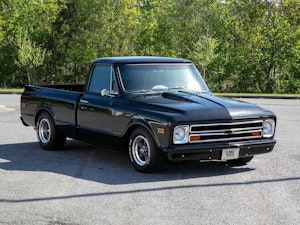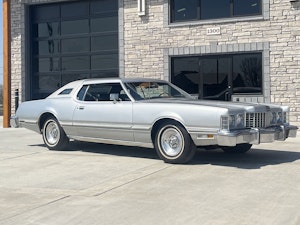Media | Articles
10 Minutes of Politics
Winning the 1966 24 Hours of Le Mans with the Ford GT40
Ford’s great victory at the 1966 24 Hours of Le Mans came in the third year of trying. The team that won did it with brains as well as the steering wheel.
In fall 1964, Ford’s Le Mans planning group sat down in Dearborn to map out the upcoming season. That year’s first forays for the GT40 had shown speed, but they knew they’d have to be even faster in ’65 to gain a margin over the new cars expected from Ferrari. Ford needed more power, ideally a reliable 450 horsepower. They found that power under the hoods of their toughest racers — the stock cars that terrorized the South.
Ford’s 427-cid V-8 won 23 races in 1963 to claim the NASCAR championship. It was easily capable of the desired output. Ford asked Kar Kraft, the Dearborn-based arm of its GT racing program, to install one in a GT40 to find out if the heavy V-8 would work. Using passenger-car parts, Kar Kraft made a new transmission to handle the 427’s torque. In what they called the GT Mark II, a new nosepiece made room for bigger radiators and wider wheels and tires.
In mid-May 1965 — only weeks before Le Mans — they tried the hybrid on Ford’s five-mile banked track. With British racer-engineer Ken Miles at the wheel, the test car lapped at an average of 201.5 mph, reaching 210 mph on the straights. Miles’s verdict was brief and to the point: “That’s the car I want to drive at Le Mans this year.”
Marketplace
Buy and sell classics with confidence
Around-the-clock work began immediately to build a second Mark II. Spoilers and fins tamed high-speed instability that team driver Phil Hill called “absolutely frightening.” Although Ford’s jury-rigged 1965 effort in France soon failed, Hill set a new Le Mans lap record at a heady 138.4 mph. The Mark II clearly had the potential that Ford was looking for.
Leo Beebe, whom Henry Ford II personally placed in charge of the racing effort, created a new organization for 1966. Carroll Shelby, who was already entering racing cars for Ford, joined the fold. Holman-Moody, hitherto mainly associated with Ford’s stock cars, also came into the GT picture.
Now, at long last, in its Mark II form, the GT was to get the intensive testing and development it should have had at the outset. Every component of the GT Mark II was proved with testing at Daytona and at Ford’s Kingman, Arizona, proving grounds. Phil Remington, Shelby’s chief engineer, led the effort to refine every part of the car.
Ken Miles summed up the tests: “We increased the engine power, and the transmission broke. We beefed up the transmission, and the transaxle broke. We strengthened the transaxle, and the hubs broke. We beefed up the hubs, and the wheels broke. We strengthened the wheels and then found that with all the extra weight we’d built in, we had to strengthen the chassis. We found that with all this speed we’d developed, the car shortened a half-inch under heavy braking. So as far as we were concerned, there was no way for the Fords to last 24 hours.
“Evidently we were wrong,” added Miles. With Lloyd Ruby, his #98 Mark II won the Daytona 24-hour race in February 1966, with Fords sweeping the podium. Sebring saw another Ford victory with the 427-powered cars finishing 1st and 2nd.
Two improved GT Mark IIs went to Le Mans for the April practice weekend. This turned tragic for Ford when veteran driver Walt Hansgen’s car aquaplaned on the damp track and he crashed mortally at high speed. Ignoring the weight penalty, Ford beefed up safety with roll cages and built-in fire extinguishers.
Ford entered eight cars at Le Mans in 1966, three each by Shelby American and Holman-Moody and two by the British Alan Mann team. This followed a Ford decree laid down after the 1965 fiasco that no team, no matter how good, could be expected to take care of more than three cars. Shelby’s star driving team was Dan Gurney with Jerry Grant. Ken Miles paired with New Zealander Denny Hulme, while two more Kiwis, Bruce McLaren and Chris Amon, drove Shelby’s third entry.
After Daytona, McLaren told his friends that he was sure Ford could win Le Mans. They scoffed, pointing out that the first-string Ferraris had not gone to Florida. For Le Mans, seven top-line Ferraris were fielded. Said Amon, “Bruce and I were fairly certain that Dan Gurney would go fast at the start, and if this happened we knew Ken Miles would go after him, so we decided to hang back.” Honorary starter for the 1966 race was none other then Henry Ford II himself. Cards distributed to the team members said, “Henry wants you to win.”
The traditional Le Mans running start was still used in 1966. “I was very careful not to break a leg running across the track and clambering into the car,” Bruce McLaren said. He took his silver-striped black Ford safely along the pit wall instead of barging out into the traffic stream. By 9 a.m. the next morning, the #2 GT40 was in the lead.
With the opposition annihilated, their Ford and the second-place Miles/Hulme Shelby American car were running half-a-minute slower than their capabilities, controlled by an “EZE” sign from the pits. But when Bruce pitted with three hours still to go, he was surprised to find the rival Ford hot on his heels: “In the previous five laps Miles had caught up about 30 seconds, when we were both supposed to be lapping at four minutes and no faster or slower. He had a very rapid pit stop and handed over to Denny.”
Watching his own pit stop as Amon took over, McLaren was surprised to see a tire changed. “A Goodyear man said, ‘Change that wheel!’” he recalled. “At the time I thought there was something fishy about it but I didn’t realize, until I thought about it, that he hadn’t looked at the wheel!
“Fifteen minutes ago we had been 30 seconds ahead,” Bruce reflected. But after the burst of speed by Miles and the suspicious tire change, “we were now about 40 seconds behind Hulme and supposed to lap calmly at the same speed until the 4 p.m. finish. I asked Shelby how the race was going to be finished. He said it had been decided to let the car that was ahead after the last pit stop win, so that it would give the crews on each car a nice feeling!” Bruce suspected that because he and Chris were Firestone-contracted drivers, the Goodyear-linked Shelby team was not about to do them any favors.
McLaren thought this was unfair. He and Chris had obeyed the slow-down orders from the pits that their rivals had ignored. He decided to act. Bruce went over Shelby’s head and pointed out that he and Amon could easily step up their pace to pass the other Ford, but that they had loyally raced to orders. He made a shrewd suggestion as well: “Why don’t you bring the cars over the line together? You are paying dearly for pictures in the paper, so get a good picture!”
Bruce’s arguments won the day. At the last pit stops an hour before the finish, the drivers were told to adjust their speeds to finish in a dead heat. McLaren and Miles were at the wheels of their respective Fords. Joined by a third, lapped, GT40, the leaders came up to the final turns together. Chris Amon recalled the sight: “Coming out of that last corner Bruce made bloody sure he was in front! He made certain that it was no dead heat, because he crossed the line two or three lengths ahead of Miles. Ken was quite upset about it.”
Ford, however, was relaxed. Said Bruce: “They were pleased the way it had come out, partly because I had been in the project from the start and partly because we didn’t race the hell out of the car at any stage.” Even without McLaren’s final spurt they would have been the winners, because they had started farther back along the pits. They covered 3,009 miles at a winning average of 125.4 mph, some 4 mph faster than the previous record.
McLaren was bemused over what he had been able to achieve. “I didn’t think 10 minutes of politics could win a 24-hour race,” he wrote home to his father. “But there you are — nice guys don’t win ball games, they say.” He and Amon were the Le Mans winners but only, as he said later, “because we didn’t accept the wool being pulled over our eyes. It’s the biggest race I’ve ever won,” Bruce added, “and the same goes for Chris — but the whole thing seemed to be so simple.”
Simple it surely was — after a crude test version of the GT40 had been transformed into a bulletproof racing car to bring Ford victory in the world’s greatest long-distance race.










